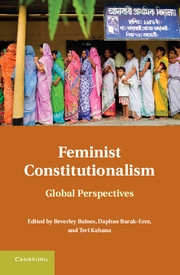Book contents
- Frontmatter
- Contents
- Foreword
- Contributors
- Introduction
- Part I Feminism as a Challenge to Constitutional Theory
- Part II Feminism and Judging
- Part III Feminism, Democracy, and Political Participation
- 9 The Gendered State and Women's Political Leadership
- 10 On Parity, Interdependence, and Women's Democracy
- 11 Women's Involvement in International Constitution-Making
- 12 Between Constitutional Jurisdiction and Women's Rights Organizations
- 13 The Promise of Democratic Constitutionalism
- Part IV The Constitutionalism of Reproductive Rights
- Part V Women's Rights, Multiculturalism, and Diversity
- Part VI Women between Secularism and Religion
- Index
- References
9 - The Gendered State and Women's Political Leadership
Explaining the American Puzzle
Published online by Cambridge University Press: 05 June 2012
- Frontmatter
- Contents
- Foreword
- Contributors
- Introduction
- Part I Feminism as a Challenge to Constitutional Theory
- Part II Feminism and Judging
- Part III Feminism, Democracy, and Political Participation
- 9 The Gendered State and Women's Political Leadership
- 10 On Parity, Interdependence, and Women's Democracy
- 11 Women's Involvement in International Constitution-Making
- 12 Between Constitutional Jurisdiction and Women's Rights Organizations
- 13 The Promise of Democratic Constitutionalism
- Part IV The Constitutionalism of Reproductive Rights
- Part V Women's Rights, Multiculturalism, and Diversity
- Part VI Women between Secularism and Religion
- Index
- References
Summary
Introduction
The United States has presented a puzzle to those trying to understand women's political representation. Political representation is a basic component of every democratic political system. Democracy refers to the participation of people in their own government, that is, the rule of the people. In a representative democracy such as the United States, the two most important components of political rule are the right to vote and the right to hold office. One of the major principles in a democratic political system is that a democratic body such as Congress should reflect the characteristics of the population. If the population is 51 percent women then something close to 51 percent women should be in representative institutions. However, as of 2008, women constitute only 16.8 percent of the House of Representatives. This means that women are underrepresented in the House by 34.1 percent. The extreme gap between the population percentage of women and their representation in the House makes women the most underrepresented subordinate group in American society, more so than that of African Americans, Hispanics, or Asians, as illustrated in Figure 9.1.
The low political representation of women in Congress also ranks the United States an abysmal eighty-fourth in the world, trailing behind comparable Western democracies such as Sweden, 47 percent, Finland, 41.5 percent, the Netherlands, 39.3 percent, Denmark, 38 percent, Spain, 36.3 percent, Belgium, 35.3 percent, Germany, 31.6 percent, and Switzerland, 28.5 percent, but also trailing behind many less wealthy and less economically privileged countries such as Ecuador, 25 percent, Seychelles, 23.5 percent, Tunisia, 22.8 percent, and Eritrea, 22 percent.
- Type
- Chapter
- Information
- Feminist ConstitutionalismGlobal Perspectives, pp. 169 - 187Publisher: Cambridge University PressPrint publication year: 2012
References
- 1
- Cited by

